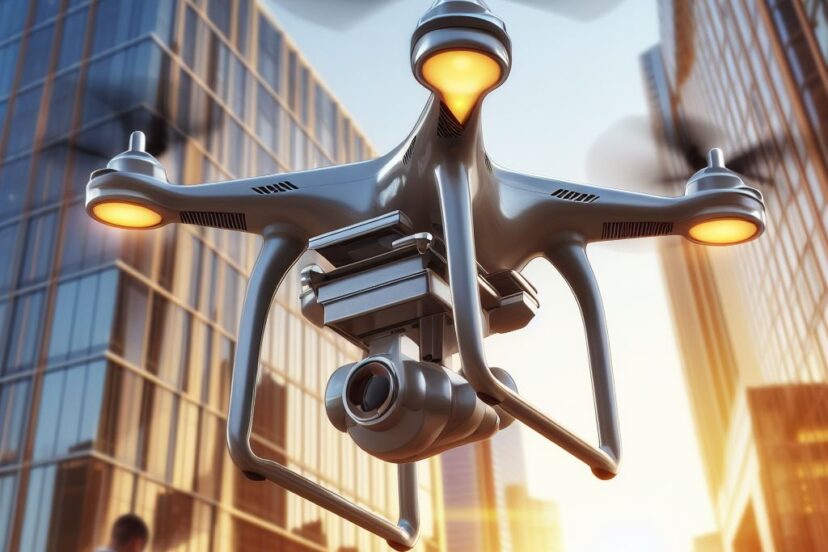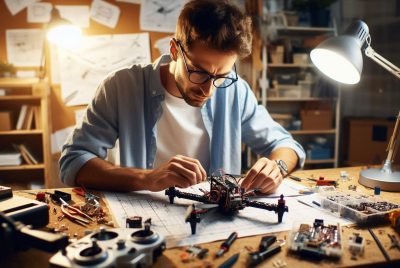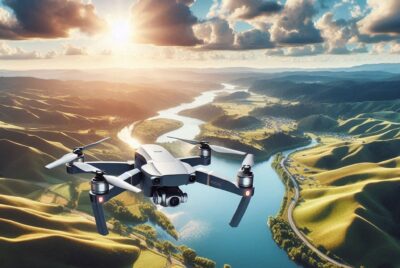Surveillance Drone: Eyes in the Sky
*We may earn a commission for purchases made using our links. Please see our disclosure to learn more.
Surveillance Drone Advancements: Navigating Modern Security Challenges
In recent years, the surveillance drone has become a pivotal tool for security and monitoring purposes, revolutionizing the way surveillance is conducted. These unmanned aerial vehicles (UAVs), equipped with advanced camera systems and sensors, enable high-resolution imaging from vantage points previously inaccessible or too costly for manned aircraft. My assessment of the industry suggests that the integration of drones into surveillance operations offers enhanced data collection capabilities with greater efficiency and fewer risks to personnel.

My exploration into the current market for surveillance drones reveals a diversity of models suited for a variety of tasks ranging from perimeter security to more sophisticated applications such as lidar-based terrain mapping and multi-modal sensing. I observe that prominent drone models, like the DJI Mavic Air series, have set industry standards by offering a balance of portability, image quality, and advanced flight features, making them well-suited for professional surveillance work. With their user-friendly interfaces, these drones are becoming indispensable in fields beyond security, including agriculture, disaster management, and filmmaking, where precise and unobtrusive monitoring is required.
Historical Development of a Surveillance Drone

In my exploration of the historical development of surveillance drones, I’ve found that their use has shifted from military beginnings to versatile civilian roles, with remarkable technological advancements driving their evolution.
Evolution from Military to Civilian Use
I’ve observed that the first unmanned aerial vehicles (UAVs), such as the Radioplane OQ-2 developed in 1939, were initially crafted for military purposes. It’s clear to me that these early drones served as reconnaissance tools, a practice that continued to expand through the decades. This was particularly notable during the Cold War era, where surveillance was a critical activity. In the 1960s, the Royal Artillery in England used the SDI surveillance drone system to boost their observation capabilities.
It wasn’t until the 2000s that I started to see a significant pivot to civilian use. By 2006, government agencies were utilizing drones for disaster relief and border surveillance, while corporations adopted them to monitor pipelines and manage agricultural tasks. The natural progression of drone technology led to an increase in various civilian applications, which expanded beyond mere observation into areas like logistics and retail.
Advancements in UAV Technology
My research uncovers that advancements in UAV technology have played a pivotal role in expanding the scope and efficiency of surveillance drones. DJI, a company established in 2006, has been instrumental in advancing drone technology. DJI’s contributions such as the DJI Mavic Air and the DJI Inspire 1 and 2 signify notable milestones in UAV design, offering enhanced stability, higher quality imaging, and more user-friendly control systems.
Furthermore, the evolution continues with the DJI Mavic 3, equipped with superior imaging capabilities and longer battery life. I find it fascinating that these technological improvements not only increase the range of possible applications but also enhance the level of detail and precision achievable during surveillance missions. The sophisticated onboard sensors and improved global positioning systems have transformed drones from rudimentary remote-controlled devices to highly autonomous and reliable tools for surveillance and data collection.
Technical Features of a Surveillance Drone

In this section, I’ll detail the sophisticated technology that goes into surveillance drones. Highlighting their cutting-edge camera systems, outstanding flight performance, and innovative autonomy features.
Camera and Sensory Capabilities
Cameras: Surveillance drones are typically equipped with high-resolution cameras, such as 4K cameras, for capturing clear and detailed imagery. These cameras often come mounted on a 3-axis gimbal to ensure stability and precise gimbal control, allowing for smooth footage even in challenging conditions.
- Thermal Imaging and Infrared: Many models come with advanced thermal sensors, including thermal cameras and infrared cameras, which are crucial for night surveillance and heat signature detection.
- Wide-Angle Cameras: These provide a broad field of view, enabling effective area coverage.
Sensory Equipment:
- LiDAR (Light Detection and Ranging): This technology is used for creating precise 3D maps of the drone’s surroundings.
- Radar: Offers another layer of environmental recognition, beneficial for terrain analysis.
Flight Performance and Stability
Drone Flight Time and Weather Resistance:
- Flight Time: I ensure lengthy operation periods, commonly offering a flight time of up to 30 minutes or more, depending on the payload and battery capacity.
- Weather Resistance: My design often includes features for resilience against adverse weather, ensuring reliability in various climatic conditions.
Flight Stability:
- Wind Resistance: I am engineered for high wind resistance, maintaining stability and control in windy scenarios.
- Automatic Flight Modes: These modes allow me to perform complex maneuvers and maintain consistent altitude and orientation without manual input.
Autonomy and Obstacle Avoidance
Autonomous Operations:
- GPS: Utilizing GPS technology, I am capable of autonomous flight paths and precise geolocation.
Obstacle Avoidance:
- My integrated obstacle avoidance systems rely on an array of sensors, including my cameras and radar, to navigate around potential hazards autonomously.
- Automatic Systems: I am programmed to respond to the environment intelligently, altering my path to maintain safety and mission continuity.
Operational Use Cases for a Surveillance Drone

Surveillance drones revolutionize monitoring and security by offering unique perspectives and real-time data, which significantly enhance safety and efficiency. From law enforcement to disaster relief, the applications are far-reaching, allowing operators to conduct missions that were previously risky or impossible.
Law Enforcement and Public Safety
My experience with security drones in law enforcement reveals that their real-time surveillance capabilities are crucial for public safety. These drones enable officers to:
- Monitor large public gatherings like protests and events to ensure crowd control and preemptively identify potential disturbances.
- Conduct search and rescue operations in hard-to-reach areas, which is vital during kidnappings and missing person cases.
Drones also support routine patrols of critical infrastructure, where they inspect and surveil without the need for constant physical presence, saving time and resources while increasing the coverage.
Agricultural and Environmental Monitoring
Drones equipped with advanced sensors are game-changers in agriculture and environmental protection. These are some specific ways I’ve seen drones make an impact:
- Monitor crop health through near-infrared sensors, enabling farmers to identify pest infestations and nutrient deficiencies before they escalate.
- Track wildlife and illegal activities such as poaching in vast forested areas, streamlining conservation efforts.
In the agricultural sector, drones for security surveillance play a significant role in ensuring both the safety and the productivity of the crops and livestock through constant monitoring.
Emergency Response and Disaster Relief
Drones promptly respond to crises, mitigating the risk to human life during emergency operations. In my work, I’ve relied on drones to:
- Provide aerial views of disaster-impacted areas, which aids in coordinating efforts and assessing damage for immediate response.
- Assist in wildfire management, using thermal imaging to detect hotspots and helping allocate firefighting resources more effectively.
The adaptability of surveillance and security drones ensures that emergency response teams are equipped with the best tools to protect public safety during critical times.
Surveillance Drone: Regulatory and Ethical Considerations

In my exploration of surveillance drones, I understand that they raise significant regulatory and ethical questions. These concerns are especially pertinent when considering privacy, government oversight, and public sentiment.
Privacy Laws and Surveillance Drones
Privacy laws play a crucial role as drones become more prevalent. They often struggle to keep pace with technological advancements. Also resulting in a lag between emerging drone capabilities and existing privacy protections. Situational awareness provided by drones must be balanced against individual privacy rights. For instance, the Fourth Amendment of the U.S. Constitution protects citizens against unreasonable searches, setting a legal framework that impacts how surveillance drones are deployed.
- Key Elements:
- Informed consent: When possible, individuals should be made aware of drone surveillance operations.
- Minimum necessary data: Collection should be limited to what is explicitly required for the operation.
Government and FAA Regulations
The Federal Aviation Administration (FAA) is the primary government agency responsible for regulating airspace, including the operation of surveillance drones. The agency has strict guidelines on drone flight patterns, altitudes, and no-fly zones to ensure safety and compliance. To conduct surveillance, government and private entities must adhere to these regulations without exception.
- FAA Regulations:
- Part 107: A comprehensive set of rules for operating small unmanned aircraft systems (UAS) that weigh less than 55 pounds.
- Special Authorizations: Required for operating drones in restricted airspace or for other specific missions.
Expectations of Privacy and Public Perception
I find that the public’s expectation of privacy is a crucial aspect of the ethical deployment of surveillance drones. Transparency regarding drone use by government agencies can alleviate concerns of misuse and foster trust. Meanwhile, educational campaigns can help inform the public about the benefits and risks associated with drone surveillance.
- Public Perception Factors:
- Transparency: Clear communication about how and why drones are used.
- Accountability: Agencies should be held responsible for misuse or overreach in surveillance activities.
My overview uncovers a regulatory and ethical landscape that continues to evolve as technology and societal norms change. It is imperative for the regulations to adapt and for ethical considerations to be consistently revisited to uphold the rights and safety of individuals.
Surveillance Drone: Emerging Technologies and Future Trends

I’m exploring how the integration of advanced technologies is shaping the future of surveillance drones, emphasizing on three significant developments. These evolutions are not just enhancing functionalities but are essential to meet the increasing demands for sophisticated surveillance.
AI and Machine Learning Integration
The incorporation of artificial intelligence (AI) and machine learning (ML) in drones is revolutionizing their capabilities. Specifically, AI enables autonomous flight, allowing drones to operate without a remote controller, and it improves object detection, crucial in crowded or complex environments. ML algorithms are constantly learning from vast amounts of data, enhancing the performance of drones over time. Compatibility with various drone models, especially in surveying and monitoring tasks, is significantly improved. Also leading to drones that are more efficient and versatile.
Drone-in-a-Box Solutions and Automation
Drone-in-a-box solutions represent a leap in drone automation. These systems allow for the rapid deployment and landing of drones, often without human intervention. You can pre-program a typical mission plan, allowing the drone to perform routine patrols and then return to its secure box, where it can recharge and download the captured data. This innovation is especially beneficial for surveillance in sensitive areas or at times when manual operation is risky or inconvenient, such as in low light conditions.
Enhanced Data Security Measures
Surveillance operations demand stringent data security measures due to the sensitive nature of their task. Nowadays, manufacturers are equipping modern drones with advanced encryption and hindrance mechanisms to safeguard the live video feeds and collected data they transmit, ensuring protection against unauthorized access. Security protocols are now an integral part of the drone’s firmware, reflecting the evolving nature of threats in the digital realm.
From VTOL (Vertical Take-Off and Landing) drone models that offer greater versatility in launch and landing to the latest consumer drone technologies filtering into professional drones, these advancements emphasize the growing need for robust security and the industry’s commitment to meeting these demands.
FAQs About a Surveillance Drone
In this section, I address some of the most common inquiries about surveillance drones, covering usage, selection criteria, performance specifications, market options, cost, and regulations.
1. How are surveillance drones utilized by the military?
Military applications of surveillance drones involve reconnaissance missions, intelligence gathering, and target identification. They provide real-time battlefield data, reducing risks to personnel while enhancing strategic decision-making.
2. What features should be considered when choosing a surveillance drone for home security?
When selecting a surveillance drone for home security, important features include camera resolution, night vision capabilities, flight time, range, autonomous operation, and the ability to integrate with home security systems.
3. What is the range and endurance of long-range surveillance drones?
Long-range surveillance drones can typically operate at significant distances from the controller, with some models capable of flying for several hours uninterrupted. The specific range and endurance vary depending on the drone model and its power module technology.
4. What are the top-rated surveillance drones currently on the market?
The top-rated surveillance drones are recognized for their advanced imaging technologies, robust construction, long-range capabilities, and reliable performance. Popular models often come from reputable brands that lead in UAV innovation.
5. How much does a typical surveillance drone cost?
The cost of surveillance drones varies widely based on features, capabilities, and design. Consumer models may start around a few hundred dollars, while professional-grade drones used for industrial or military purposes can run into thousands.




